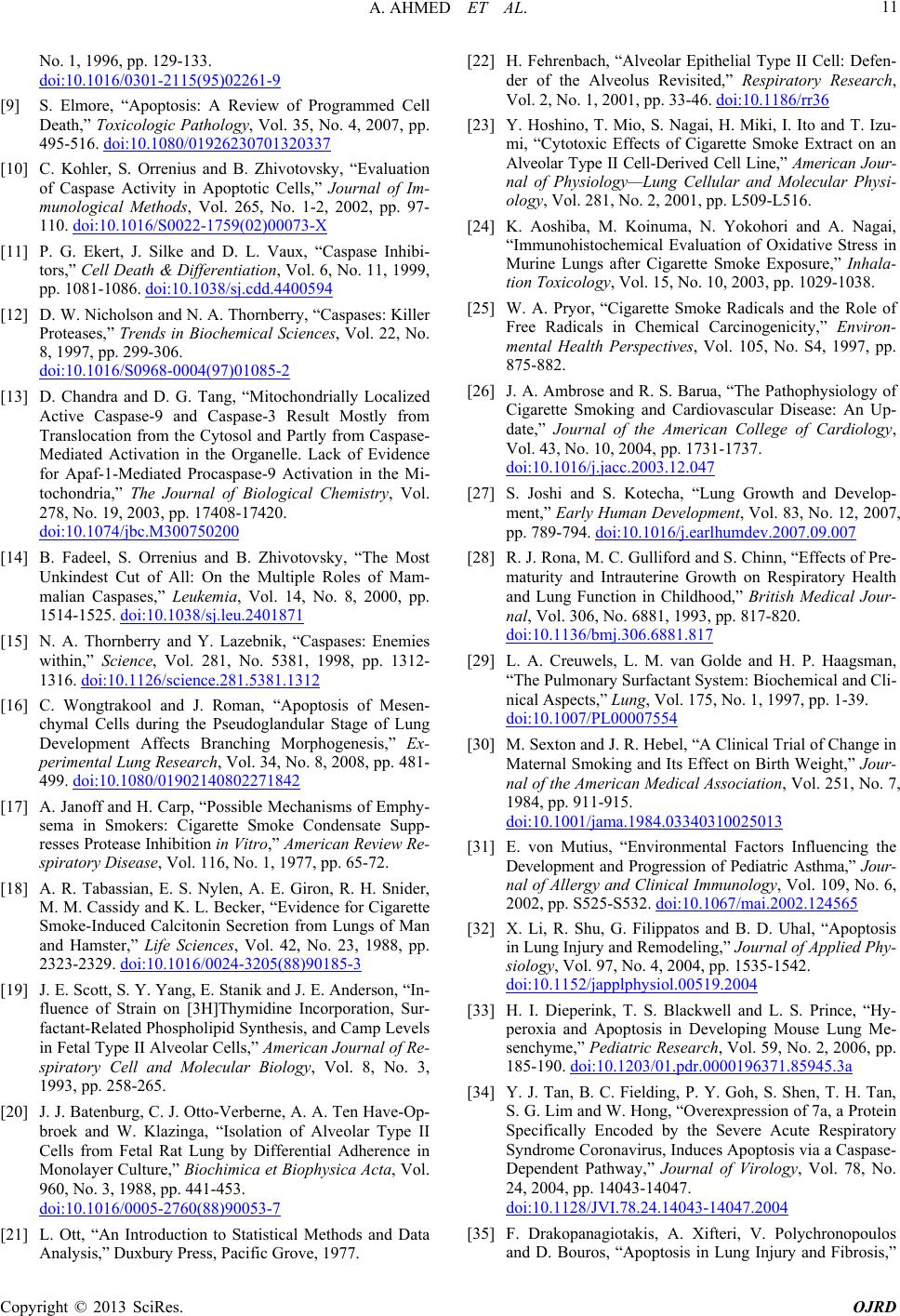
A. AHMED ET AL. 11
No. 1, 1996, pp. 129-133.
doi:10.1016/0301-2115(95)02261-9
[9] S. Elmore, “Apoptosis: A Review of Programmed Cell
Death,” Toxicologic Pathology, Vol. 35, No
495-516.
. 4, 2007, pp.
20337doi:10.1080/019262307013
002, pp. 97-
[10] C. Kohler, S. Orrenius and B. Zhivotovsky, “Evaluation
of Caspase Activity in Apoptotic Cells,” Journal of Im-
munological Methods, Vol. 265, No. 1-2, 2
110. doi:10.1016/S0022-1759(02)00073-X
[11] P. G. Ekert, J. Silke and D. L. Vaux, “Caspase Inhibi-
tors,” Cell Death & Differentiation, Vol. 6, No. 11, 1999,
pp. 1081-1086. doi:10.1038/sj.cdd.4400594
[12] D. W. Nicholson and N. A. Thornberry, “Caspases: Killer
Proteases,” Trends in Biochemical Sciences, Vol. 22, No.
8, 1997, pp. 299-306.
doi:10.1016/S0968-0004(97)01085-2
[13] D. Chandra and D. G. Tang, “Mitochondrially Localized
Active Caspase-9 and Caspase-3 Re
Translocation from the Cytosol and Pa
sult Mostly from
rtly from Caspase-
Mediated Activation in the Organelle. Lack of Evidence
for Apaf-1-Mediated Procaspase-9 Activation in the Mi-
tochondria,” The Journal of Biological Chemistry, Vol.
278, No. 19, 2003, pp. 17408-17420.
doi:10.1074/jbc.M300750200
[14] B. Fadeel, S. Orrenius and B. Zhivotovsky, “The Most
Unkindest Cut of All: On the Multip
malian Caspases,” Leukemia, le Roles of Mam
Vol. 14, No. 8, 2000, pp
-
.
1514-1525. doi:10.1038/sj.leu.2401871
[15] N. A. Thornberry and Y. Lazebnik, “Caspases: Enemies
within,” Science, Vol. 281, No. 5381, 1998, pp. 1312-
1316. doi:10.1126/science.281.5381.1312
ogenesis,
[16] C. Wongtrakool and J. Roman, “Apoptosis of Mesen-
chymal Cells during the Pseudoglandular Stage of Lung
Development Affects Branching Morph” Ex-
perimental Lung Research, Vol. 34, No. 8, 2008, pp. 481-
499. doi:10.1080/01902140802271842
[17] A. Janoff and H. Carp, “Possible Mechanisms of Emphy-
sema in Smokers: Cigarette Smoke Condensate Supp-
resses Protease Inhibition in Vitro,” American Review Re-
spiratory Disease, Vol. 116, No. 1, 1977, pp. 65-72.
[18] A. R. Tabassian, E. S. Nylen, A. E. Giron, R. H. Snider,
M. M. Cassidy and K. L. Becker, “Evidence for Cigarette
Smoke-Induced Calcitonin Secretion from Lungs of Man
and Hamster,” Life Sciences, Vol. 42, No. 23, 1988, pp.
2323-2329. doi:10.1016/0024-3205(88)90185-3
[19] J. E. Scott, S. Y. Yang, E. Stanik and J. E. Anderson, “In-
fluence of Strain on [3H]Thymidine Incorporation, Sur-
factant-Related Phospholipid Synthesis, and Camp Levels
t Lung by Differential Adherence
in Fetal Type II Alveolar Cells,” American Journal of Re-
spiratory Cell and Molecular Biology, Vol. 8, No. 3,
1993, pp. 258-265.
[20] J. J. Batenburg, C. J. Otto-Verberne, A. A. Ten Have-Op-
broek and W. Klazinga, “Isolation of Alveolar Type II
Cells from Fetal Ra in
Monolayer Culture,” Biochimica et Biophysica Acta, Vol.
960, No. 3, 1988, pp. 441-453.
doi:10.1016/0005-2760(88)90053-7
[21] L. Ott, “An Introduction to Statistical Methods and Data
Analysis,” Duxbury Press, Pacific
[22] H. Fehrenbach, “Alveolar Epithelial
Grove, 1977.
Type II Cell: Defen-
der of the Alveolus Revisited,” Respiratory Research,
Vol. 2, No. 1, 2001, pp. 33-46. doi:10.1186/rr36
[23] Y. Hoshino, T. Mio, S. Nagai, H. Miki, I. Ito and T. Izu-
mi, “Cytotoxic Effects of Cigarette Smoke Extract on an
Alveolar Type II Cell-Derived Cell Line,” American Jour-
nal of Physiology—Lung Cellular and Molecular Physi-
ology, Vol. 281, No. 2, 2001, pp. L509-L516.
[24] K. Aoshiba, M. Koinuma, N. Yokohori and A. Nagai,
“Immunohistochemical Evaluation of Oxidative Stress in
Murine Lungs after Cigarette Smoke Exposure,” Inhala-
tion Toxicology, Vol. 15, No. 10, 2003, pp. 1029-1038.
[25] W. A. Pryor, “Cigarette Smoke Radicals and the Role of
Free Radicals in Chemical Carcinogenicity,” Environ-
mental Health Perspectives, Vol. 105, No. S4, 1997, pp.
875-882.
[26] J. A. Ambrose and R. S. Barua, “The Pathophysiology of
Cigarette Smoking and Cardiovascular Disease: An Up-
date,” Journal of the American College of Cardiology,
Vol. 43, No. 10, 2004, pp. 1731-1737.
doi:10.1016/j.jacc.2003.12.047
[27] S. Joshi and S. Kotecha, “Lung Growth and Develop-
ment,” Early Human Development, Vol. 83, No. 12, 2007,
pp. 789-794.
doi:10.1016/j.earlhumdev.2007.09.007
[28] R. J. Rona, M. C. Gulliford and S. Chinn, “Effects of Pre-
maturity and Intrauterine Growth on Respiratory Health
and Lung Function in Childhood,” British Medical Jour-
nal, Vol. 306, No. 6881, 1993, pp. 817-820.
doi:10.1136/bmj.306.6881.817
[29] L. A. Creuwels, L. M. van Golde and H. P. Haagsman,
“The Pulmonary Surfactant System: Biochemical and Cli-
nical Aspects,” Lung, Vol. 175, No. 1, 1997, pp. 1-39.
doi:10.1007/PL00007554
[30] M. Sexton and J. R. Hebel, “A Clinical Trial of Change in
Maternal Smoking and Its Effect on Birth Weight,” Jour-
nal of the American Medical Association, Vol. 251, No. 7,
1984, pp. 911-915.
doi:10.1001/jama.1984.03340310025013
[31] E. von Mutius, “Environmental Factors Influencing the
Development and Progression of Pediatric Asthma,” Jour-
nal of Allergy and Clinical Immunology, Vol. 10
2002, pp. S525-S532.
9, No. 6,
2.124565doi:10.1067/mai.200
[32] X. Li, R. Shu, G. Filippatos and B. D. Uhal, “Apoptosis
in Lung Injury and Remodeling,” Journal of Applied Phy-
siology, Vol. 97, No. 4, 2004, pp. 1535-1542.
doi:10.1152/japplphysiol.00519.2004
[33] H. I. Dieperink, T. S. Blackwell and L. S. Prince, “Hy-
peroxia and Apoptosis in Developing Mouse Lung Me-
senchyme,” Pediatric Researc h, Vol. 59, No. 2,
185-190. doi:10.1203/01.pdr.00001963
2006, pp.
71.85945.3a
[34] Y. J. Tan, B. C. Fielding, P. Y. Goh, S. Shen, T. H. Tan,
S. G. Lim and W. Hong, “Overexpression of 7a, a Protein
Specifically Encoded by the Severe Acute Respiratory
Syndrome Coronavirus, Induces Apoptosis via a Caspase-
Dependent Pathway,” Journal of Virology, Vol. 78, No.
24, 2004, pp. 14043-14047.
doi:10.1128/JVI.78.24.14043-14047.2004
[35] F. Drakopanagiotakis, A. Xifteri, V. Polychronopoulos
and D. Bouros, “Apoptosis in Lung Injury and Fibrosis,”
Copyright © 2013 SciRes. OJRD